I visited the Outer Hebrides in 2013. I wouldn’t have seen all I did but for Dave of Dave’s archeological tours, which I highly recommend. The best books to buy there or take with you is Ancient Lewis and Harris by Christopher Burgess and Ancient Uists by Anna Badcock. I have numbered the sites according to their numbering. It really is worth seeing all the stone circles, not just going to the main one. This whole area was ceremonial for Neolithic people. My photos are sometimes thumbnails: click on them and you will see them bigger and better. The entries are more or less alphabetical. With limited time I concentrated on the Neolithic sites, rather than anything later.
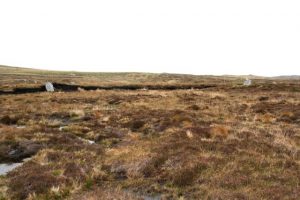 Not a pretty site. Peat cutting has exposed the stones that are now fallen and lying in water. This stone circle was discovered in 1981 and could do with more archeological investigation and a bit of restoration. This site is off the A 858 and is marked on the Leisure and Tourist Map.
Not a pretty site. Peat cutting has exposed the stones that are now fallen and lying in water. This stone circle was discovered in 1981 and could do with more archeological investigation and a bit of restoration. This site is off the A 858 and is marked on the Leisure and Tourist Map.
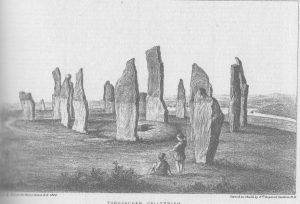 Calanais, also called Callanish, is a 13 stone circle with a central monolith, with single rows to the south, east and west and an avenue from the north. The photo at the top of the page does not do it justice. To get the full impression you need a photo taken from the air. The nineteenth engraving on the right is taken from Gerald Ponting’s small book, Callanish.
Calanais, also called Callanish, is a 13 stone circle with a central monolith, with single rows to the south, east and west and an avenue from the north. The photo at the top of the page does not do it justice. To get the full impression you need a photo taken from the air. The nineteenth engraving on the right is taken from Gerald Ponting’s small book, Callanish.
No 17 in Ancient Lewis and Harris
There is probably a small stone circle below two cairns that lead to a ridge overlooking Callanish. Thumbnail photos below. Those who want to know more must read Dave Godwin’s dissertation, The Neolithic & Early Bronze Age in Lewis and Harris.
There are five standing stones, all that remain from an oval stone ring, with two fallen stones. Just as there were smaller stone circles, now disappeared, built near Avebury, Calanais 11 is not far from Calanais 1
The peat was dug away from this in 1848 and charcoal remains suggested there may have been a wood monument which preceded this one.
No 18 in Ancient Lewis and Harris.
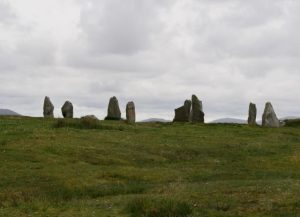 Eight stones left standing and five fallen in an outer ring with four stones in a group within. This is within a few kilometers of Calanais 1.
Eight stones left standing and five fallen in an outer ring with four stones in a group within. This is within a few kilometers of Calanais 1.
No 18 in Ancient Lewis and Harris.
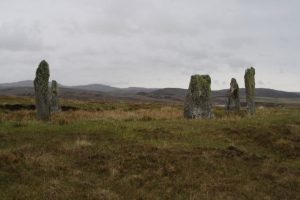 An oval ring with five standing stones. There is a stile off the B8011.
An oval ring with five standing stones. There is a stile off the B8011.
No 19 in Ancient Lewis and Harris.
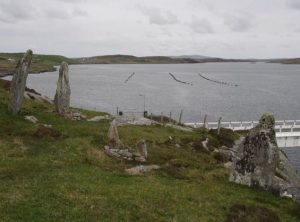 Just near the Bernera Bridge. There are four stones all facing across the water in what might be semi-circle rather than a circle. The surface was cobbled originally. This is a startingly beautiful site about which there is little information. For a little more, read: http://portal.historicenvironment.scot/designation/SM5548
Just near the Bernera Bridge. There are four stones all facing across the water in what might be semi-circle rather than a circle. The surface was cobbled originally. This is a startingly beautiful site about which there is little information. For a little more, read: http://portal.historicenvironment.scot/designation/SM5548
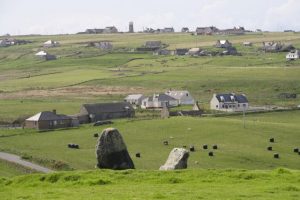 On the road to the medieval fort, you will see these two standing stones in a field. Probably the remains of a chambered tomb.
On the road to the medieval fort, you will see these two standing stones in a field. Probably the remains of a chambered tomb.
Clach an Trushall, the Stone of Compassion, is the tallest standing stone on Lewis, near some houses in Baile an Trushall. Probably part of a more extensive monument as there is an orthostat embedded in a nearby wall. Two fallen stones lie nearby. There are the remains of a stone circle recorded to the south east.
No 8 in Ancient Lewis and Harris.
On the headland above the Bostadh iron age village. Bostadh is lovely beach with a reconstructed iron age hut and rabbits playing in the churchyard. A good place for a picnic. If you walk inland up the little river and look right you will see the dolmen tomb high on the skyline. Follow a wall upwards to reach it. This is a rare kind of tomb for Lewis. The capstone points towards the sea.
Bostadh is no 20 in Ancient Lewis and Harris. The dolmen is not mentioned: only the iron age village and reconstructed iron age house.
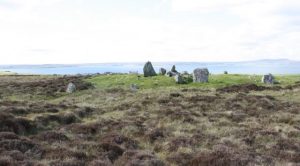 This seems to have been a square cairn, maybe with a forecourt on the south east. There’s a circular walk which takes in a small triangular stone.
This seems to have been a square cairn, maybe with a forecourt on the south east. There’s a circular walk which takes in a small triangular stone.
No 28 in Ancient Lewis and Harris
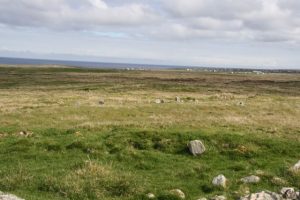 Steinacleit chambered cairn, or stone circle, or possibly oval farm? Probably a prehistoric settlement with an enclosure for farm animals. It has not been proper excavated and so possible dates are 1800–1500 BC or 3000–1500 BC. The Shetland page has more on prehistoric settlements.
Steinacleit chambered cairn, or stone circle, or possibly oval farm? Probably a prehistoric settlement with an enclosure for farm animals. It has not been proper excavated and so possible dates are 1800–1500 BC or 3000–1500 BC. The Shetland page has more on prehistoric settlements.
No 9 in Ancient Lewis and Harris.
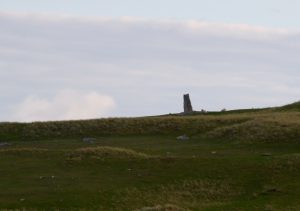 Gloriously sited standing stone looking over the sea. There may have been other standing stones near it. There’s a parking place on the A859 at Traigh Iar. The hollows and humps in front of it are the remains of a wheelhouse (see Uist later!).
Gloriously sited standing stone looking over the sea. There may have been other standing stones near it. There’s a parking place on the A859 at Traigh Iar. The hollows and humps in front of it are the remains of a wheelhouse (see Uist later!).
No 42 in Ancient Lewis and Harris
A standing stone on the headland between Bagh Stèinigidh and Tràigh Mhòr. Originally one of over a dozen standing stones set in a large circle in a henge-like ditch. These are now fallen or absent altogether and the ditch is filled in.
No 44 in Ancient Lewis and Harris.
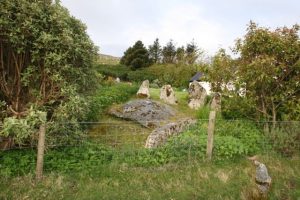 Neolithic chambered cairn that has been incorporated into a private garden. Luckily you can see this from the road. The huge fallen stone in the middle is the capstone. It is possible that the standing stones have been moved to make way for the road which is the A859!
Neolithic chambered cairn that has been incorporated into a private garden. Luckily you can see this from the road. The huge fallen stone in the middle is the capstone. It is possible that the standing stones have been moved to make way for the road which is the A859!
No 41 in Ancient Lewis and Harris
A cairn, much longer than most of the cairns in the Outer Hebrides, with a horned forecourt entrance. Some of the upright stones of the chamber walls are visible. No 28 in Ancient Uists
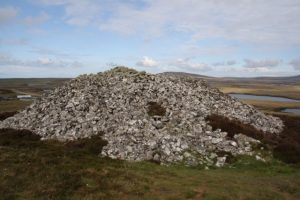 An amazingly well preserved chambered cairn with a huge mount of stones just below the crest of the hill (traditional siting for Cotswold long barrows). There was a forecourt leading to the entrance and an internal burial chamber with 6 stone slabs supporting a corbelled roof. Signed posted from the A865.
An amazingly well preserved chambered cairn with a huge mount of stones just below the crest of the hill (traditional siting for Cotswold long barrows). There was a forecourt leading to the entrance and an internal burial chamber with 6 stone slabs supporting a corbelled roof. Signed posted from the A865.
No 22 in Ancient Uists
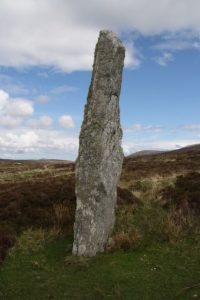 A huge standing stone off the committee road, a road build to provide work during the famine of the 1840s. This stone often has the same name as one in South Uist.
A huge standing stone off the committee road, a road build to provide work during the famine of the 1840s. This stone often has the same name as one in South Uist.
Ruins of another cairn close by perhaps.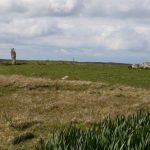
No 41 in in Ancient Uists
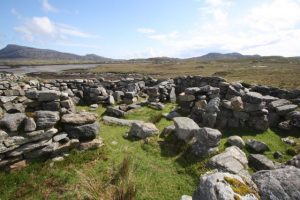 In an area where trees were non existent, these were all-stone houses build round a central hearth with pillars made of dry stone walling instead of wood, always scare in Shetland. This one, relatively well preserved was excavated by an amateur so we don’t know quite as much about it as we would like. There’s an even better preserved one in Jarlshof on the Shetland page. Read The Lost Wheelhouses of Uist by Susan Hothersall and Robert Tye for more detail.
In an area where trees were non existent, these were all-stone houses build round a central hearth with pillars made of dry stone walling instead of wood, always scare in Shetland. This one, relatively well preserved was excavated by an amateur so we don’t know quite as much about it as we would like. There’s an even better preserved one in Jarlshof on the Shetland page. Read The Lost Wheelhouses of Uist by Susan Hothersall and Robert Tye for more detail.
No 29 in in Ancient Uists
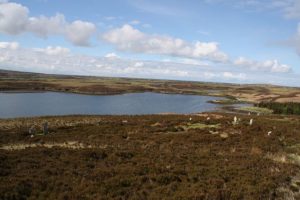 A stone circle called Fingal’s People, after a Gaelic hero Fionn Mc Cumhaill. There remain about 40 stones still erect with portal stones making two entrances. There is walk between this and Barpa Langais cairn. Two of the portal
A stone circle called Fingal’s People, after a Gaelic hero Fionn Mc Cumhaill. There remain about 40 stones still erect with portal stones making two entrances. There is walk between this and Barpa Langais cairn. Two of the portal 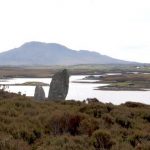 stones can be seen on the right.
stones can be seen on the right.
No 23 in in Ancient Uists
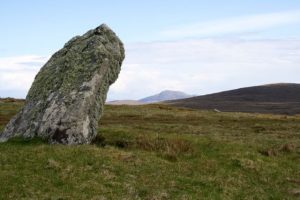 Confusingly sometimes known as Beinn a’Charra (see above) in North Uist. The name I have used means “The Limpet stone of Freya,” the Norse goddess.
Confusingly sometimes known as Beinn a’Charra (see above) in North Uist. The name I have used means “The Limpet stone of Freya,” the Norse goddess.
No 41 in Ancient Uists